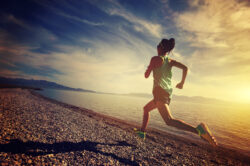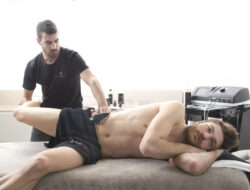Which services can offer a physiotherapist to an amateur sportsman?
Amateur sport represents a great opportunity for those who practice physiotherapy. But how is it possible to grasp it? First of all you need to get an idea of what can be useful for an amateur sportsman who wants to train while having fun without incurring injuries. So, which services can a physiotherapist offer to an amateur sportsman?
 In physiotherapy there is a lot of focus on rehabilitation, pain, injury, inflammation. Sometimes it is forgotten that the typical skills of those who practice this noble profession could open up many (not too much) hidden opportunities.
In physiotherapy there is a lot of focus on rehabilitation, pain, injury, inflammation. Sometimes it is forgotten that the typical skills of those who practice this noble profession could open up many (not too much) hidden opportunities.
Taking running only into consideration, the number of people in the world who participate (and finish) an official competition is now close to 10 million every year. Europe and the United States represent an important share of these numbers, but even in Asia this sport is seeing an increase in its “practitioners”. To this we can add the millions of people who go to the gym at least once a week and the countless “Sunday sports” who go to the park to train or organize a soccer or tennis match. The reasons that push us to practice it are varied: having fun, losing weight, traveling, relieving stress, gaining self-esteem, a sense of competition but regardless of the reason why people practice it, amateur sport represents a great opportunity for a physiotherapist!
The point is simple: there are a lot of people who play amateur sport and each of them has physical needs that go beyond recovering from an injury.
Among these we think, for example: eating so as to facilitate performance, following a consistent workout with respect to your goal, taking care of your body to avoid adverse events associated with sports.
There are thousands of different possible needs. Many of these can be answered in physiotherapy. Among many possibilities there may be a question …
WHICH SERVICES CAN OFFER A PHYSIOTHERAPIST TO AN AMATEUR SPORTSMAN?
The answer is simple …
A TREATMENT PROGRAM FOR MUSCLE RECOVERY
 From our recent survey we found that the centers that provide this type of service and have managed to carve out a recognized name in this area, in their territory, are able to apply rates on average 25% higher than centers that focus exclusively on traditional rehabilitation.
From our recent survey we found that the centers that provide this type of service and have managed to carve out a recognized name in this area, in their territory, are able to apply rates on average 25% higher than centers that focus exclusively on traditional rehabilitation.
The specialization can be deep and require very technical skills, but even before getting to topics such as the optimization of biomechanics, the analysis of support points and proprioceptive response, posturo-kinetic refinement, the visceral components that impact on VO2 , explosiveness, frequency, rebound, WATT / kg etc… you can start with muscle recovery. For a relatively simple reason:
The most useful element is (fortunately) also the simplest to stimulate … if you have the right tools!
If you search for “muscle recovery” on PUBMED, over 40,000 results appear. It is a topic of rather relevant scientific interest.
If you look through some studies, you can see how muscle recovery is significantly correlated with blood perfusion and microcirculation. The reason is that the supply of oxygen-laden blood allows the body to dispose of the catabolites generated during exertion and at the same time allows it to carry the nutrients necessary to restore the state of energy homeostasis of muscle tissue.
But which tools are able to stimulate deep blood perfusion associated with an increase in tissue oxygen saturation for which published studies are available to prove its effects?
If you have come this far you are probably someone who loves to learn more. At this link you can find a video about the effects on blood perfusion stimulated by a T-Plus instrument. At the end of the video you will also find the references to download a study published in a journal at Impact Factor that deals with this topic.
HERE IS A SCHEMATIC EXAMPLE OF MUSCLE RECOVERY TREATMENT FOR AN AMATEUR SPORTSMAN THROUGH A TECAR INSTRUMENT PARAMETERED ON 30 MINUTES
* The parameters shown below refer to a T-Plus model tecar instrument. It may not be possible to apply the same energy levels with other tools. Energy levels are calculated for a 75kg person.
SET UP
- PATIENT: prone
- TOT TIME: 30 minutes
- PLATE POSITION: under the abdomen maximizing contact surface
PHASE 1
- ELECTRODE: RESISTIVE (maximum size available – at least 8 cm in diameter)
- JOULE TO TRANSFER: 50 Kilojoules (approximately 480 seconds)
- AVERAGE CURRENT: 1.2 Ampere
- DISTRICTS ON WHICH TO PLACE THE ELECTRODE: Glutes, hamstring, adductors, fascia latae, gastrocnemius, tibialis, achilleus tendon (myotendinous junction), plantar fascia. The homogeneous distribution of joules on the individual districts must be parameterized to the mass of the district (more mass, more time)
PHASE 2
- ELECTRODE: FLAT HYPERTHERMIC CAPACITIVE
- JOULE TO TRANSFER: 140 VA x 480 seconds
- AVERAGE CURRENT: 0.5 Ampere
- DISTRICTS ON WHICH TO PLACE THE ELECTRODE: Glutes, hamstring, adductors, fascia latae, gastrocnemius, tibialis, achilleus tendon (myotendinous junction), plantar fascia. The homogeneous distribution of joules over the individual districts must be parametric. to the district mass.
PHASE 3
- ELECTRODE: HYPOTHERMAL CAPACITIVE
- JOULE TO TRANSFER: 15 VA * 240 seconds
- AVERAGE CURRENT: 0.15 Ampere
- DISTRICTS ON WHICH TO PLACE THE ELECTRODE: where thermal homeostasis is required (on any areas where the temperature has increased over 37 ° as a result of previous applications)
* Repeat Phase 1 and Phase 2 bilaterally.
SOME IMPORTANT NOTES
This is just a schematic example of a basic treatment. In order to obtain excellent results it is necessary to modulate the treatment on the characteristics of the person and it is essential to pay attention to the tests on biomechanics. The range of motion of the coxo-femoral joint in flexion, extension, hypertension and more generally the amplitude of the step are some factors to focus on in order to understand whether to allocate more or less energy in the pelvis area. Another important aspect is the joint mobility of the ankle. Its laxity or rigidity on the different planes of movement will be a relevant input to define how much energy to allocate to this district during the treatment.
IN ADDITION TO MUSCLE RECOVERY, THERE ARE AT LEAST 3 OTHER TOPICS THAT ARE AN OPPORTUNITY FOR THOSE WHO PRACTICE PHYSIOTHERAPY TO SUPPORT PERFORMANCE
- DOMS
- Pre-workout biomechanical optimization
- Improvement of sleep quality
Each of these topics is a job opportunity and the effectiveness of the treatments will depend on the ability to act on:
- Inflammatory process
- Viscoelasticity of the fabric
- Concentration of cortisol
- Balance between sympathetic and parasympathetic systems with respect to the therapeutic goal
The key is to understand how to act on these aspects quickly, deeply and clinically relevant to the goal.
YOU MAY STILL HAVE MANY QUESTIONS IN YOUR HEAD
- How do I translate a muscle recovery treatment into a service to offer to my patients?
- Can I see some examples of treatment to get a more precise idea?
- Is the tool I have suitable for this?
- How many treatments do you need?
- How much energy is needed and how do I calculate it?
- Are there any other variables to consider?
- Where do I put the plate?
- Where do I put the electrode?
- Are mobilizations needed in particular?
- Which parts of the body should I start from?
- Resistive or capacitive?
To answer these questions and all those you may have on these topics, we have created a one and a half hour webinar that will be useful for you to learn more about the aspects related to supporting a sports performance with a tecar tool. Find out by clicking on this link.




